|
|
|||||||||||
|
|
|||||||||||
 |
|||||||||||
|
|
|||||||||||
|
![]()
|
Guo Weihan - missing link in the history of Xingyiquan found? by Jarek Szymanski |
| Text and photos - Jarek Szymanski; © J.Szymanski 2002 |
|
|
While reading books written both in China and abroad, it often appears that what we know about the history of Xingyiquan is more a collection of tales and oral transmissions than true facts based on historical records. From time to time some "facts" so far considered to be obvious are questioned and only then we get closer to the truth, although seldom can actually know it completely. While the question "who was Li Laoneng's teacher" is not the topic of this article, I hope the information here will show some obvious problems with what so far has been accepted without questioning. Only because of such situations new claims are made, which indirectly let us learn about rare styles that otherwise would hardly be heard of. As already mentioned in the article about the origins and development of Dai Family Xinyiquan, we are still not clear how Xinyiquan as taught by Dai Clan in Shanxi province was transmitted to Li Laoneng, who is considered the father of Xingyiquan. |
|
The group of Guo Weihan's Xinyiquan practitioners whom I interviewed during my research trip to Shanxi. The noodles were delicious and local liquors strong but I wonder if all the material presented in this article could have been collected without the help of Baijiu... |
|
Hebei Xingyiquan practitioners claim that Li Laoneng learnt from Dai Longbang and this version can be found in Sun Lutang's "The Study of Xingyiquan" published in 1916 where in "Author's Preface" Sun wrote: "(...)Mister Dai Longbang transmitted (Xingyiquan) to Mister Li Luoneng (of Zhili i.e. today's Hebei Province)". In 1923 Sun Lutang published his another book - "True Description of the Meaning of Boxing" ("Quan Yi Shu Zhen") where he gave detailed account of Li Laoneng's meeting with Dai Longbang and study under Dai: "Mr.Li named Feiyu, styled himself Nengran, and was called Mr.Laoneng (...) went to Taigu in Shanxi (Province) in business; (he was) fond of martial arts. (There) he heard about Mr. Dai Longbang, living in the (Taigu) county who excelled in Xingyiquan and went to visit him. When they met, both the speech and manners (of Mr.Dai Longbang) were very elegant and refined, unlike of somebody who excels in martial arts, which surprised (Li Laoneng) so he left. On another day (Li Laoneng) through formal introduction became (Dai Longbang's) disciple. At that time Mister (Li Laoneng) was thirty seven. After receiving instructions (from Dai Longbang) (Li Laoneng) was practicing days and nights, but in two years' time he only learnt one part of Wuxing (Five Elements) - Pi Quan (Chopping Fist) and half of the Lian Huan Quan (Linked Fists) set. Although he did not learn much, but he did not look for more and was practicing with sincerity without break. One year Dai Longbang's mother was celebrating her 80 birthday and Mister (Li Laoneng) went to congratulate her on her birthday. The guests there were either relatives, friends and Mr. Longbang's disciples. After the birthday ceremony those who knew martial arts were demonstrating in the birthday hall, and each was showing everything what he knew. Mister (Li Laoneng) only demonstrated half of the (Linked Fists) set. Mr. Longbang's mother liked martial arts and knew all movements and principles of Xingyiquan; she then (after the demonstration) asked Mr. (Li Laoneng) why he demonstrated only half of the set, and Mister (Li Laoneng) answered "I only learnt this". (Dai Longbang's mother) immediately turned to Mr. Longbang ordering him "this man studied for two years but was taught so little; he looks very loyal and sincere, so this method can be taught to him with concentrated attention." Since Mr. Longbang was a dutiful son and besides received instruction from his mother in person, so he taught everything he learnt to Mister (Li Laoneng). Mister (Li Laoneng) was practicing meticulously and achieved high skill at the age of forty seven". However the main problem is the time frame - Dai Longbang is believed to live between 1720 and 1809 (according to Cao Jizhi's "The Course of Dai Shi Xinyiquan"), while Li Laoneng - 1803 and 1888 (Meng Xianshi: "Detailed Explanation of Xingyiquan"; Li Laoneng was employed by one of Meng ancestors to protect their property). Hence it seems impossible that Li learnt from Dai Longbang.
On the other hand Xingyiquan practitioners from Shanxi Province, with the center in Taigu County, consider Dai Wenxiong, Dai Longbang's second son, as Li Laoneng's master. |
|
The only "hard evidence" is the text of "Memorial Tablet of Mister Che Yizhai" written in 1925 - other texts, like "The Essence of Xinyi" ("Xinyi Jingyi") attributed to Li Guangheng, Li Laoneng's disciple from Shanxi, and said to be written in 1895, can hardly be considered evidence as nobody has been allowed to have a closer look at its contents (although recently a research team from Japan took photos of the cover and table of contents of the book). The text on "Memorial Tablet of Mister Che Yizhai", which still stands in Taigu, says: "Martial arts are the unique skills of China and are divided into Shaolin, Internal and External Schools. These arts were flourishing in our prefecture during the reigns of emperors Xianfeng (1851-1861) and Tongzhi (1862-1874) (and were practiced by) disciples of Wang Changle and Dai Wenxiong. (Wang) Changle was from Jiao (i.e. Jiaocheng County). Mister Dai had a nickname Er Lü and was from Qi (County). Dai Family Xinyiquan, passed within Dai Clan, belongs to Shaolin External branch, and was transmitted outside (the family) to Li Laoneng (...)" Since Dai Wenxiong lived between 1769 and 1861, this claim seems more reasonable than that of Hebei. |
Che Yizhai's Memorial Tablet in Taigu, Shanxi Province |
|
|
|
Of these two "origin" versions the one from Hebei Province - Li Laoneng being Dai Longbang's disciple - was more popular and for a long time considered "the only truth". Shanxi practitioners were loyal to their transmission and have been trying to prove their point. However, with China's "revolutionary opening" to the outside world and as a result of Wushu Excavating and Sifting which took place in 1982/1983, more and more traditional martial arts came out into light. It was at that time when first articles about Dai Family Xinyiquan were published and the name of Guo Weihan as Li Laoneng's teacher was mentioned.
Dai Family Xinyiquan practitioners claimed Guo Weihan was nephew of Dai Longbang's wife (her brother's son) and learnt early Xinyiquan from Dai Longbang. According to Cao Jizhi, author of "The Romance of Qing Dynasty Knights", a novel about Dai Clan and their family art, and unofficial "spokesman" for Dai Family Xinyiquan practitioners, Guo Weihan learnt only the martial art of the system and did not study the health preserving part, with Monkey Squatting method as its core. Cao in his another book - "The Course of Dai Family Xinyiquan" made several claims concerning Guo Weihan:
In 1998 I interviewed Dai Family Xinyiquan practitioners living in Guo Weihan's hometown and they confirmed that it was Guo who taught Li Laoneng. We did not go into details concerning how Guo Weihan's system really looked like and it became obvious that more information can be obtained only from the practitioners of Guo Weihan's style.
Some time later I had a chance to have a look at a very interesting book - "Secret Methods of Xingyiquan Basic Practice" (Xingyiquan Jiben Xinggong Mifa) written by Gao Jiangheng and published in 1935. In his book Gao Jiangheng recorded stories told by his teacher, Jia Dajun (Guo Weihan's disciple) as well as described basic practice methods of his style. The contents of the book was different from anything I had heard about Guo Weihan's system before. 1.Historical part of the book sheds completely new light on the early history of Xinyiquan as well as relations between Dai Longbang, his sons, Guo Weihan and Li Laoneng (this issue however will be further discussed in one of the next articles on this site). According to Gao's book (chapter on "Origins") Guo Weihan was nephew of Dai Longbang's wife - although in the light of new "discoveries" this relation does not seem to be true but this question will be briefly discussed below - and learnt his martial art from Dai Longbang. In 1838 he went to Henan's Shijiadian together with Dai Wenliang and Dai Wenxiong to help in managing the inn Dai Longbang ran there and learn martial arts. In 1841 Niu Xixian (Niu Xixian was Niu Gao's descendant; Niu Gao was one of the general's in Yue Fei's army and Yue Fei's disciple) came to Shijiadian and Guo Weihan and Dai brothers became his disciples and learnt martial arts from him. Gao Jiangheng also mentions that there was an oral transmission of Dai brothers and Guo Weihan learning from Li Zheng while in Shijiadian. In the generation chart in his book Gao places Guo Weihan on the same level (same generation) as Dai brothers, below Dai Longbang and Niu Xixian, but above Li Luoneng and Dai Wuchang, Dai Liangdong, Wen Laoliu, Jia Dajun (Gao's teacher) and others. |
|
| First movements of Six Combinations Stick (Liu He Gun) routine of Guo Weihan's system performed by Mr. Lϋ Hui, Fan Jiayuan's student: |
Since Guo went to Shijiadian in 1838 to help Dai Longbang manage Dai's business there, it not only puts the dates for Dai Longbang's life given by Cao Jizhi into question, but also makes it possible that Li Laoneng actually learnt from Dai. Some recent discoveries concerning Li Zheng (said to be one of Dai's teachers - please refer to this article) also seem to support the idea that Dai Longbang could have lived much later than Cao indicated. 2.Technical part of the book introduces the basic theory and practice methods of Guo Weihan's Xingyiquan (as Xingyiquan - Form-Intent Boxing - is the name Gao refers to his style): 1.Sixteen Core Methods (Shi Liu Ben) 2.Sixteen Powers (Shi Liu Jin) 3.Meditation Practices divided into three levels: 3.1.Method of Using Qi (Yong Qi Fa) - breathing/meditation method to attain calmness of mind so that Qi can move; 3.2.Heavenly Circle Method (Zhou Tian Fa) - on the basis of the "Method of Using Qi" one learns to lead Qi along Small Heavenly Circle; 3.3.Method of Achieving the Truth (De Zhen Fa) - high level meditation practice 4.Dantian Methods - divided into Dantian Practice in Standing (Zhan Dantian) and Dantian Practice in Movement (Ben Dantian): 4.1.Dantian Practice in Standing - is a method similar to Squatting Monkey method of Dai Family Xinyiquan, composed of two phases - opening and contracting of the body. The main difference is in the way arms are held in squatting position - according to Gao they should be crossed in front of the body with backs of palms kept close to chicks. 4.2.Dantian Practice in Movement - is a footwork method which should be, as Gao Jianheng writes in his book "(...) like shooting an arrow, where Dantian is a bow and Qi - the arrow. This is called Neigong (Internal Method). On the outside hands are like a bow, leg is like an arrow. (...) In the past Master Dai Erlü was able to attack the opponent from the distance of ten steps (...) it was the skill coming from Ben Dantian". Gao Jiangheng gives detailed description of Dantian methods practiced within Guo Weihan's system, and the main one - Zhan Dantian - with slight differences is the same as Squatting Monkey method of Dai Family Xinyiquan. This is in contradiction with Cao Jizhi's claim that Guo's style does not include the Daoyin part - i.e. Squatting Monkey method - of Dai Family system. 5.Six Harmonies Method (Liu He Fa) - once Dantian is developed and basic coordination achieved one should practice "Six Harmonies Posture" (Liu He Shi) - a standing posture which links the body and mind according to "Six Harmonies" - between Mind (Xin) and Intent (Yi), Intent and Qi, Qi and Strength (Li), hands and feet, shoulders and hips, elbows and knees. It is a single weighted standing posture - for left Six Harmonies Posture most of the weight of the body is on right leg, left leg is in front, both legs bent (Gao's book suggests that one should be in a squatting position with hips and knees on one level), upper body twisted with left shoulder facing forward, left hand is by the right knee while right hand at the left shoulder protecting the face. 6.Five Elements Fists (Wu Xing Quan) - while Dai Family Xinyiquan, Shanxi and Hebei branches of Xingyiquan and Guo Weihan's style all include Five Elements Fists, each of these styles practices them in a different way. Wu Xing in Guo Weihan's style show many differences and are more complex when compared to their counterparts in either Dai Family Xinyi or Xingyiquan.
|
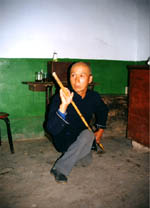 |
|
| 1 | |
| ¤ | |
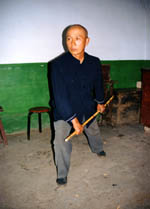 |
|
| 2 | |
| ¤ | |
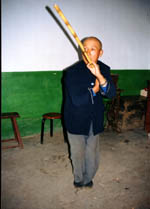 |
|
| 3 | |
| ¤ | |
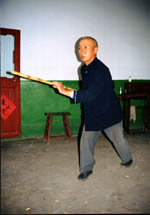 |
|
| 4 | |
|
Pi Quan (Splitting Fist) of Guo Weihan's system as introduced in Gao Jiangheng's book (Guo WeihangJia DajungGao Jiangheng lineage): |
||||
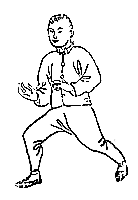 |
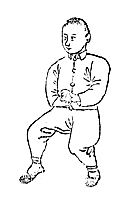 |
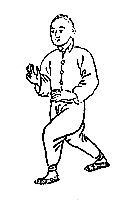 |
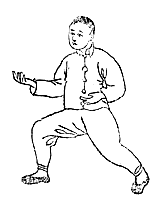 |
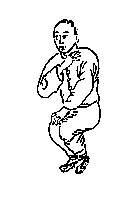 |
| 5 | ˇ 4 | ˇ 3 | ˇ 2 | ˇ 1 |
| Chopping Fist Right Posture |
Embracing the Moon |
Chopping Fist - Left Posture | Snake Form |
Six Harmonies Posture |
| Pi Quan You Shi | Huai Zhong Bao Yue | Pi Quan Zuo Shi | She Xing | Liu He Shi |
All Five Elements Fists start from Six Harmonies Posture and the main linking movement is the "Embracing the Moon" (Huai Zhong Bao Yue) posture. They also contain animal movements (Snake Form, Chicken Form) as well as other techniques not included in animal forms (Cannon Towards Heaven). The techniques are usually performed in Bow and Arrow Stance (Gong Jian Bu), also referred to as Tiger Step (Hu Bu). 7.Twelve (Animal) Shapes (Shi Er Xing) - twelve sets of short, linked sequences; the movements that these sequences are composed of can also be practiced as single techniques. Twelve Shapes are: Dragon (Long), Tiger (Hu), Monkey (Hou), Horse (Ma), Nag (Tai), Cat (Mao), Swallow (Yan), Sparrow Hawk (Yao), Eagle (Ying), Chicken (Ji), Crane (He), Snake (She). Not only the Animals are different than those in Xingyiquan, but the specific movements are different as well - for example Dragon Shape is a set of the following movements: Wrapped Body and Hidden Hand of Dragon Shape Posture (Guo Shen Cang Shou Long Xing Shi) - Heart-dividing Palm (Fen Xin Zhang) - Dragon's Tail Posture (Long Wei Shi). In his book Gao gives no information concerning weapons practiced within Guo Weihan's system.
In 1998 I made the first but not very successful attempt to meet Guo Weihan's style practitioners in Shanxi Province. I was only able to meet students of Ma Erniu (Dai Kui's disciple), Dai Family Xinyiquan practitioners, who lived in Guo Weihan's hometown. Although I did not see the style itself and still had no idea how it looked like, I was told interesting story about Li Laoneng coming to Shanxi, how he was rejected by Dai Clan and finally accepted by Guo Weihan as a disciple. |
|
In May 2001 I had a chance to finally meet practitioners of Guo Weihan's style, not only talk to them, but also videotape some demonstrations as well as take photos. The following information was shared with me during conversations I had with Guo Weihan's style practitioners in Shanxi's countryside: 1.Guo Weihan and his disciples - facts and stories: There is no doubt Guo Weihan really existed - his name appears on Shenzhou - sheet of fabric on which the names of the dead belonging to one clan are recorded and which is hang on the wall during main Chinese festivals so that the living can kneel in front of it and pay respect to the dead ancestors - of Guo Clan. However the only information recorded there is Guo's name, the fact that he was 15th generation of Guo Clan and that he had three wives - Fan, Yue and Li. |
Another photo of Xinyiquan practitioners from Guo Weihan's lineage. 'Shenzhou' of Guo clan hangs in the background |
|
|
|
Enlarged fragment of 'Shenzhou' with Guo Weihan's name and surnames of his three wives |
Guo Weihan's aunt (father's sister) was married to Dai Longbang, so Guo Weihan and Dai's sons - Dai Dalü and Dai Erlü - were cousins. Guo Weihan studied Dai Family Xinyiquan from Dai Longbang. Guo spent some time in Henan escorting caravans together with Dai Longbang and his sons. After he came back to Shanxi he became the chief of his home village. Later he resigned and became a teacher teaching in one of the local private schools (Si Dian). NOTE: At the end of March 2001 an important discovery was made - Dai Clan descendants revealed four volumes of their family chronicles (Dai Shi Jiapu) as well as their Shenzhou that had been kept hidden in Dai Longbang's mansion for at least a century. Both materials are under strict protection of the local authorities and only a few persons were allowed to see them. I had a long conversation with the head of the local Cultural Relics Bureau who is one of the persons responsible for the protection of the books and Shenzhou. According to the Chronicles Dai Longbang (Dai Xing'guo), 19th generation of Dai Clan, had two wives - Zhao and Liu. He had two sons - older Dai Wenliang (Dai Dalü) and younger Dai Wenxiong (Dai Erlü), who also styled himself Dai Yemeng. |
|
|
|
|
Thanks to this discovery we can disregard the stories about two brothers - Dai Longbang and Dai Lingbang - that can be found in some of older Xingyiquan books. However at the same time the relation between Dai Longbang and Guo Weihan has to be corrected as well - since none of Dai Longbang's wives was of Guo family, Guo Weihan could not be the nephew of any of Dai Longbang's wives. There is a possibility that one of Dai Longbang's brothers could have been married to Guo Weihan's aunt, but this would have to be checked either with the Chronicles or Shenzhou. Guo Weihan had eight main disciples, of which names of only five were mentioned to me: Guo San'er, Cheng Da, Cheng Er, Li Laoneng (of Shenzhou in Hebei Province) and Lü Haigen. |
|
Guo Saner killed somebody during a fight in his hometown and had to flee to Beijing where he hid under assumed name Li. His Qing Gong (Light Skill) was very good and he was probably the renowned "Li the Swallow" famous in the capital city. Cheng Da and Cheng Er were brothers and Guo Weihan's boxing manual (Quan Pu) is still kept by their descendants. Li Laoneng came to Shanxi and wanted to learn Dai Family Xinyiquan. Li bought some land and was growing vegetables there. At that time Dai Longbang already passed away and Dai Erlü, who was very respected locally and of high social status, did not agree to accept Li as a student. As a result Li decided to ask Guo, another of Dai Longbang's disciples, to teach him, but since he was afraid that Guo would not accept him either, he was everyday pushing a cart with vegetables to Guo's house and selling the vegetables to Guo. It was Lü Haigen, Guo Weihan's "page boy" (Shu Tong) who was always coming out and buying the vegetables from Li. After some time Guo finally came out. Li grasped two handles of the cart and lifted the heavy cart full of vegetables to let Guo choose them and at the same time to show him his strength. Guo chose the vegetables and gave Li a bronze coin to pay. Guo was holding the coin with three fingers and in spite of the efforts Li could not take it from him. |
Fan Jiayuan, one of Lü Haigen's grand-students and main teacher of the current practitioners of the style |
|
|
|
Then Guo broke the coin with his fingers. Seeing this Li wanted to cross hands with Guo, but Guo defeated him easily using Snake Form (She Xing). After the fight Li kneeled in front of Guo and asked to be accepted as disciple. Although Guo agreed to teach him, the style he taught was a changed version which was based on San Ti Shi, and which Guo called Xingyiquan - Form and Intent Boxing. After some time Dai Erlü heard that Guo was teaching the man from Hebei and became quite unhappy with him. Guo invited Dai Erlü to his house and while Li Laoneng was practicing the style he learnt from Guo in the courtyard, Dai, sitting inside the house, was taking a peep at him through a little hole in the window (windows at that time had no glasses, but a half-transparent paper was used instead). Dai Erlü was not worried anymore seeing that Li did not learn his family art. Li Laoneng spent three years studying Xingyiquan and then went to Taigu. 2.The transmission of Guo Weihan's art: Guo Weihan also passed his art to Lü Haigen (1812-1904), who in turn taught Guo He (1872-1959, who started his studies under Lü at the age of 12). Guo He taught Fan Jiayuan (1909-1997). Fan's main disciples are: Yang Runsheng (1924-1996; the first disciple), Yang Liren, Fan Zhengming, Lü Hui (Lü Shuangniu), Guo Yingchang and Guo Yingsheng. The people I interviewed were mainly Fan Jiayuan's disciples. |
|
|
Home ▪ About me ▪ Updates ▪ Taiji ▪ Bagua ▪ Xinyi-Xingyi ▪ Other Styles ▪ News ▪ Store ▪ Community ▪ Email